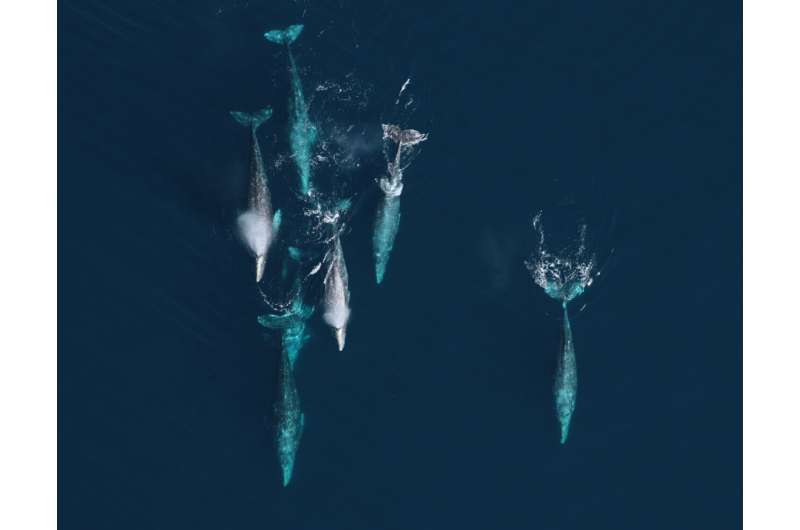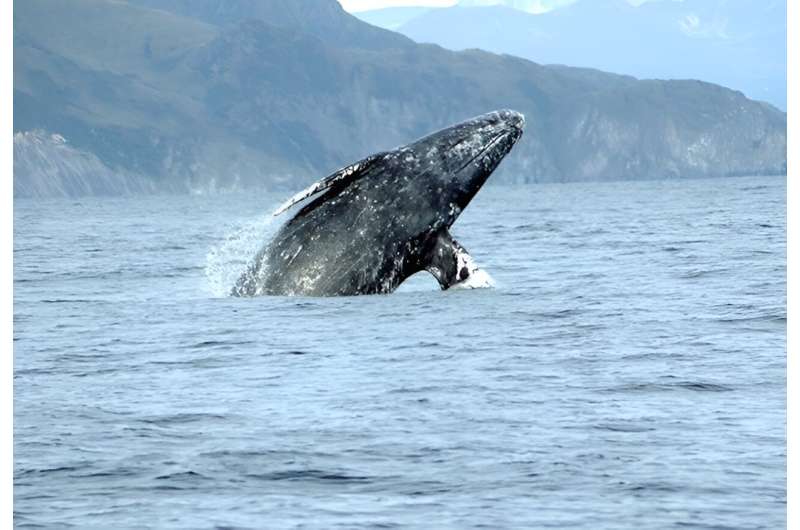This article has been reviewed according to Science X's editorial process and policies. Editors have highlighted the following attributes while ensuring the content's credibility:
fact-checked
peer-reviewed publication
trusted source
proofread
Gray whales experience major population swings as a result of Arctic conditions, research shows

Dynamic and changing Arctic Ocean conditions likely caused three major mortality events in the eastern North Pacific gray whale population since the 1980s, a new study has found.
During each of these die-offs, including one that began in 2019 and is ongoing, the gray whale population was reduced by up to 25% over just a few years, said Joshua Stewart, an assistant professor with Oregon State University's Marine Mammal Institute and the study's lead author.
"These are extreme population swings that we did not expect to see in a large, long-lived species like gray whales," Stewart said. "When the availability of their prey in the Arctic is low, and the whales cannot reach their feeding areas because of sea ice, the gray whale population experiences rapid and major shocks."
"Even highly mobile, long-lived species such as gray whales are sensitive to climate change impacts. When there are sudden declines in the quality of prey, the population of gray whales is significantly affected."
The findings were published in the journal Science.
Eastern North Pacific gray whales are one of the few populations of large whales that have recovered to what may be similar numbers that existed prior to commercial whaling. As the population has approached levels close to what their Arctic feeding areas can support, they have likely become more sensitive to environmental conditions due to competition for limited resources, Stewart said.
The unfavorable Arctic conditions that led to two die-offs in the 1980s and the 1990s were not permanent, and the population quickly rebounded as conditions improved.
"It turns out we didn't really know what a healthy baleen whale population looks like when it isn't heavily depleted by human impacts," he said. "Our assumption has generally been that these recovering populations would hit their environmental carrying capacities and remain more or less steady there. But what we're seeing is much more of a bumpy ride in response to highly variable and rapidly changing ocean conditions."

Eastern North Pacific gray whales, which currently number about 14,500, migrate more than 12,000 miles each year along the Pacific Coast, from the warm waters off the coast of Baja California, Mexico, in the winter months to the cold, productive waters of the Arctic to feed in the summer months.
Researchers at the National Oceanic and Atmospheric Administration Southwest Fisheries Science Center in La Jolla, California, have been conducting long-term population monitoring studies of these whales since the 1960s, tracking abundance, birth and death rates and monitoring body condition using aerial images.
This extensive research has made this population of gray whales the most closely studied large whale population on the planet, providing a unique window into the population dynamics of the species.
"This research demonstrates the value of long-term data in understanding not only the species under study but also the environment it depends on," said Dave Weller, director of the Southwest Fisheries Science Center's Marine Mammal and Turtle Division.
"When we began collecting data on gray whales in 1967, little did we realize the important role they would play in understanding the effects of climate change on an iconic sentinel species in the Pacific. This research would not have been possible without our reliable long-term record."
The eastern North Pacific gray whale population, which was hunted to near extinction before a whaling moratorium was enacted, has been viewed as a conservation success story because of the population's rapid recovery in the post-whaling era.
In 2019, when a high number of gray whale strandings began occurring along the Pacific coast, Stewart, a researcher at the Southwest Fisheries Science Center at the time, began looking more closely at the long-term data to see if he could learn more about what might be driving the unusual mortality event.
By combining the long-term data sets on the gray whale population with extensive environmental data from the Arctic, Stewart and his collaborators determined that the two "unusual mortality events" declared by NOAA in 1999 and 2019 were tied to both sea ice levels in the Arctic and the biomass of seafloor-living crustaceans that gray whales target for food.
Stewart also identified a third die-off in the 1980s that followed a similar pattern but was not associated with higher numbers of strandings, likely due to lower reporting rates of stranded whales prior to the 1990s.
The researchers found that years with less summer sea ice in the gray whales' Arctic feeding areas provided increased foraging opportunities that benefited the population. However, in the long term, decreasing sea ice cover, a result of rapid and accelerating climate change, most likely will not be beneficial to gray whales.

Benthic amphipods, the calorie-rich prey that gray whales prefer, are also sensitive to sea ice cover. Algae that grow underneath sea ice sink to the seafloor, enriching the amphipod population. Less ice leads to less algae reaching the seafloor, warmer water that favors smaller benthic crustaceans and faster currents that reduce habitat for gray whales' preferred prey.
"With less ice, you get less algae, which is worse for the gray whale prey," Stewart said. "All of these factors are converging to reduce the quality and availability of the food they rely on."
For the gray whales, less prey availability ultimately leads to die-offs. The most recent event is still considered ongoing and has continued significantly longer than the two earlier events.
"We are in uncharted territory now. The two previous events, despite being significant and dramatic, only lasted a couple of years," Stewart said. "The most recent mortality event has slowed and there are signs things are turning around, but the population has continued to decline. One reason it may be dragging on is the climate change component, which is contributing to a long-term trend of lower-quality prey."
Gray whales have lived through hundreds of thousands of years of environmental change and have adapted over that time to changing conditions, making extinction due to climate change unlikely, Stewart said.
"I wouldn't say there is a risk of losing gray whales due to climate change," he said. "But we need to think critically about what these changes might mean in the future. An Arctic Ocean that has warmed significantly may not be able to support 25,000 gray whales like it has in the recent past."
More information: Joshua D. Stewart et al, Boom-bust cycles in gray whales associated with dynamic and changing Arctic conditions, Science (2023). DOI: 10.1126/science.adi1847. www.science.org/doi/10.1126/science.adi1847
Journal information: Science
Provided by Oregon State University



















